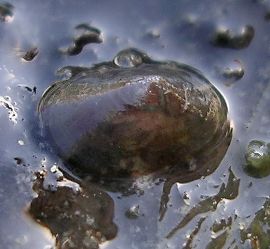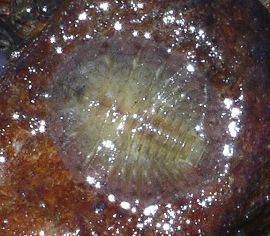
Freshwater Limpet
By the time I was three years old, I dreamed of the ocean. I'd seen pictures in books of fabulous seashells, colorful crabs, insanely strange fish and weird creatures that didn't even look like animals. With names like Sea Cucumber, Chiton, Tunicate, Brittle Star, Jellyfish and Ctenophore, such oddities were like science fiction realized. These and more could be found, so I understood, by simply walking on the beach to see what had washed up. Like most kids, I had an insatiable appetite for novel discoveries, and just about everything in my short existence fit the bill. But the limited array of mostly brown-colored small animals that lived in rivers and lakes around us just didn't seem as intriguing as the seemingly endless variety found in saltwater.
I grew up in northern Illinois where the only naturally occurring water was fresh, and, before the Clean Water Act of 1972, often quite polluted with chemicals. In spite of the odd smells and glistening sheen of oil, many of the ponds and streams did contain an interesting assortment of aquatic animals. Vertebrates were easy to find, recognize and understand. They were somewhat like us, having a backbone, pair of eyes, tail and such. We kept fish, tadpoles, snakes and turtles as pets. But, early on,
 Freshwater Limpet |
My family spent many weekends at the Kankakee and Fox Rivers, Forked Creek, and local ponds, lakes and quarries just outside of Chicago. While my parents were off fishing, I spent a lot of time messing about in the water, using a small net, turning over rocks, and examining aquatic plants for things adhering to them. I would put anything slightly unusual into a jar or bucket and later try to figure out what it was. Probably not so surprising given the popularity of the unusual, it was easier to find books that focused on the exotic saltwater animals of the seashore than on our mundane freshwater fauna. Without internet, a knowledgeable person to ask, or anything more than a Golden Nature Guide called Pond Life at hand, my guesses at identifications were not particularly accurate. But that urge to attach labels to all the animals I saw, which, by the way, is extremely deep-rooted in human evolution, had to be satisfied.
 Water Penny (a beetle larva) |
Our aquariums often held an odd assortment of animals besides fish. I knew the very commonplace creatures, such as crayfish, dragonfly naiads and water mites. Those belonged, respectively, in crustaceans, insects and arachnids. But there were also "worms" which included everything from leeches to horsehair worms to planarians. Basically, anything that was sort of long and slender was lumped into this category. The really tiny animals were also a puzzle. How did daphnia, cyclops, vorticella, and hydras fit in to the overall picture? At least insect larvae were relatively easy to recognize for what they were. After all, it's a cinch to count six legs. But figuring out what they turned into was another matter. I often didn't know exactly which little wiggly denizen turned into the damselfly, mayfly or caddisfly that ended up darting around near the ceiling of my bedroom. And many of those immature insects didn't live long enough to make it to adulthood so I couldn't discern their identity from the final clue.
Some of the most delightful curiosities were the freshwater counterparts to more familiar saltwater animals. Even though they look like small lobsters, crayfish were just so common that I did not really appreciate their resemblance. However, the rare freshwater shrimps were far more intriguing. Small and nearly transparent, they were particularly special because they were, well, shrimp, and they looked EXACTLY like the saltwater versions. One creature that I never found, but certainly hoped to one day encounter, was the elusive freshwater jellyfish. I'm still waiting for that one. Freshwater sponges were more appealing in theory than the reality of these small, nondescript rock encrusting animals.
There were plenty of snails and clams in Midwestern streams and lakes. But none of the snails were anything like the porcelain beauties that could be found at the seashore. They were ALL just plain brown. Some of the clams (for some reason called mussels, even though they don't look anything like those edible types found in saltwater), though, had lovely internal pink, purple or blue nacre, often with lovely iridescent rainbow highlights. We even found the occasional pearl.
One kind of snail did pique my interest, and a recent encounter with this was one of the germs of this particular essay.
 Freshwater Sponge near Damselfly Naiad |
There was one mystery animal that I never figured out until I was an adult. Small, flat, round armored arthropods clung to the submerged rocks along the shores of rivers. The only thing we could think of that looked remotely similar were chitons. There was just one obvious problem with this label, though, and that was the not insignificant detail that chitons are mollusks and these definitely were not. They seemed to be some sort of insect, since they had six legs on the underside. Their grip was tenacious and it was difficult to pry them off to get a good look. When dislodged, they would sort of curl up and seem to be very unhappy. I still think of them as "chitons" even though now I know they are beetle larvae and the official common name is "water penny." Funny, they didn't look like pennies at all when I was a kid, and I still don't think they do.
I mentioned earlier that a recent discovery of limpets in a pond helped spark this short writing. There was another sighting that contributed as well: an easily recognized example of a freshwater sponge. Those that I'd seen as a kid were not particularly impressive, being just sort of shapeless masses attached to sticks and other underwater substrate. This one was not noticed until I looked at a photo I took of a damselfly naiad clinging to the underside of a rock that I had turned over in the clear, fast-flowing water of a local creek here in Texas. Below the damselfly's head was a patch of lighter color sort of smeared over the rock, stretching out in all directions and containing the very well-formed round openings that are characteristic of sponges. I hardly ever saw sponges in the Illinois waters decades ago and, since then, had seen none at all. After so many years, this new find was both a pleasant surprise and a bit nostalgic, reminding me of the wonders that are everywhere around us. All we need to do is pay attention.